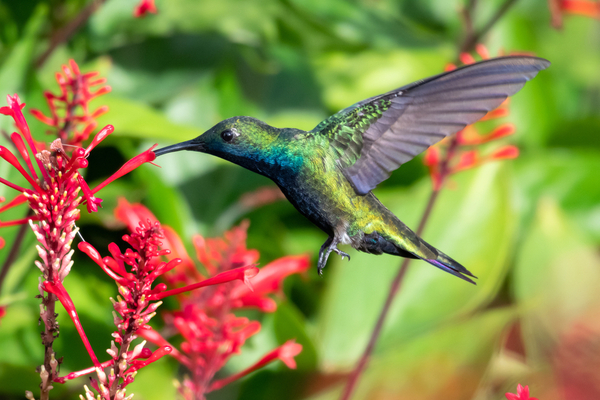Hummingbirds are on the move, and soon, these fast-feathered birds will be fluttering through gardens all across the eastern and central United States.
After spending the winter in Central and South America, ruby-throated hummingbirds have been migrating northward across the United States. During the second half of April, they typically appear in New York, Pennsylvania, Ohio, Michigan, Indiana, Illinois, Wisconsin, Iowa and Nebraska, according to Mississippi State University Extension Service.
As of April 16, they have been spotted as far north as Philadelphia, Columbus and Cincinnati, Ohio, Indianapolis, St. Louis and Kansas City. And as the calendar flips to May, they will have spread into the Northeast and Midwest, thousands of miles away from their wintertime roosts.
Here’s how you can prepare your garden for hummingbirds.
Filling a nectar feeder with sugar water is commonplace for folks who are trying to attract hummingbirds, but that isn’t the only source of nutrition they seek out.
“Hummingbirds actually need a variety of food types. Insects are another important source of food, especially during the nesting season. They consume spiders and many types of flying insects,” Mississippi State University said on its website. “Because of this, it is very important not to use pesticides on plants when providing for the needs of hummingbirds.”
Lily, fuchsia, honeysuckle and azaleas are a handful of plants that flower in the springtime that attract hummingbirds. They can also help to provide the birds with shelter and a place to nest. House Beautiful has an extensive list for you to reference.
“Most hummingbird flowers are tubular in arrangement or shape, scentless, brightly colored, and easy for hummingbirds to hover around,” Mississippi State University said. The more plants the better when it comes to getting the attention of hummingbirds, and they can be just as helpful as bees because pollen stuck to their feathers can help to pollinate plants in bloom.
Want a resource to keep at home? The Cornell Lab of Ornithology has a complete FREE guide you can order from their website.
—
Photo Credit: Chelsea Sampson / Shutterstock.com
